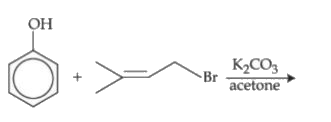Which of the following reaction follows SN1 mechanism ?
(CH3)3C−CH2Cl+CH3OK
(CH3)2CHCH2Cl+KCN
(CH3)3C−Cl+NaOH(aq).
(CH3)2CHI+H2O
The correct Answer is:C
To determine which reaction follows the SN1 mechanism, we need to understand the characteristics of the SN1 mechanism and the stability of carbocations formed during the reaction.
1. Understanding the SN1 Mechanism:
- The SN1 (Substitution Nucleophilic Unimolecular) mechanism involves two main steps:
1. Formation of a carbocation intermediate by the dissociation of the leaving group (e.g., halide).
2. Nucleophilic attack on the carbocation.
- The rate of the reaction depends only on the concentration of the substrate (alkyl halide), hence it is unimolecular.
2. Stability of Carbocations:
- The stability of carbocations is crucial for the SN1 mechanism. The order of stability is:
- Tertiary (3°) > Secondary (2°) > Primary (1°) > Methyl (0°).
- More stable carbocations are more likely to form and thus favor the SN1 mechanism.
3. Analyzing the Given Options:
- We will analyze each option to determine the type of carbocation formed upon dissociation.
Option 1: (CH3)3CCl
- Upon dissociation, it forms a tertiary carbocation (CH3)3C+.
- This is a stable carbocation, favoring the SN1 mechanism.
Option 2: CH3CH2Cl
- Upon dissociation, it forms a primary carbocation CH3CH+2.
- This is a less stable carbocation, not favoring the SN1 mechanism.
Option 3: (CH3)2CHCl
- Upon dissociation, it forms a secondary carbocation (CH3)2CH+.
- This is a moderately stable carbocation, which can undergo SN1 but is not as favorable as a tertiary carbocation.
Option 4: CH3CH2CH2Cl
- Upon dissociation, it forms a primary carbocation CH3CH2CH+2.
- This is also a less stable carbocation, not favoring the SN1 mechanism.
4. Conclusion:
- The only option that forms a stable carbocation and thus follows the SN1 mechanism is Option 1: (CH3)3CCl.
Final Answer:
Option 1: (CH3)3CCl follows the SN1 mechanism.
- The SN1 (Substitution Nucleophilic Unimolecular) mechanism involves two main steps:
1. Formation of a carbocation intermediate by the dissociation of the leaving group (e.g., halide).
2. Nucleophilic attack on the carbocation.
- The rate of the reaction depends only on the concentration of the substrate (alkyl halide), hence it is unimolecular.
- The stability of carbocations is crucial for the SN1 mechanism. The order of stability is:
- Tertiary (3°) > Secondary (2°) > Primary (1°) > Methyl (0°).
- More stable carbocations are more likely to form and thus favor the SN1 mechanism.
- We will analyze each option to determine the type of carbocation formed upon dissociation.
- Upon dissociation, it forms a tertiary carbocation (CH3)3C+.
- This is a stable carbocation, favoring the SN1 mechanism.
- Upon dissociation, it forms a primary carbocation CH3CH+2.
- This is a less stable carbocation, not favoring the SN1 mechanism.
- Upon dissociation, it forms a secondary carbocation (CH3)2CH+.
- This is a moderately stable carbocation, which can undergo SN1 but is not as favorable as a tertiary carbocation.
- Upon dissociation, it forms a primary carbocation CH3CH2CH+2.
- This is also a less stable carbocation, not favoring the SN1 mechanism.
- The only option that forms a stable carbocation and thus follows the SN1 mechanism is Option 1: (CH3)3CCl.
Option 1: (CH3)3CCl follows the SN1 mechanism.
Topper's Solved these Questions
Similar Questions
Knowledge Check
Which of the following reaction follows SN1 mechanism ?
A(CH3)3C−CH2Cl+CH3OKB(CH3)2CHCH2Cl+KCNC(CH3)3C−Cl+NaOHD(CH3)2CHl+H2OWhich of the following reactions follows concerted mechanism ?
ASN1BSN2CE1DE2The following reaction proceeds by which mechanism ?
 ASN1BSN2CE2DE1
ASN1BSN2CE2DE1
The following reaction proceeds by which mechanism ?

View SolutionThe following reaction proceeds by which mechanism ?

View SolutionThe following reaction proceeds by which mechanism ?

View SolutionThe following reaction proceeds by which mechanism ?

View SolutionThe following reaction proceeds by which mechanism ?

View Solution

